Column: Need a sidewalk fixed in L.A? It could take City Hall 10 years, if you’re lucky
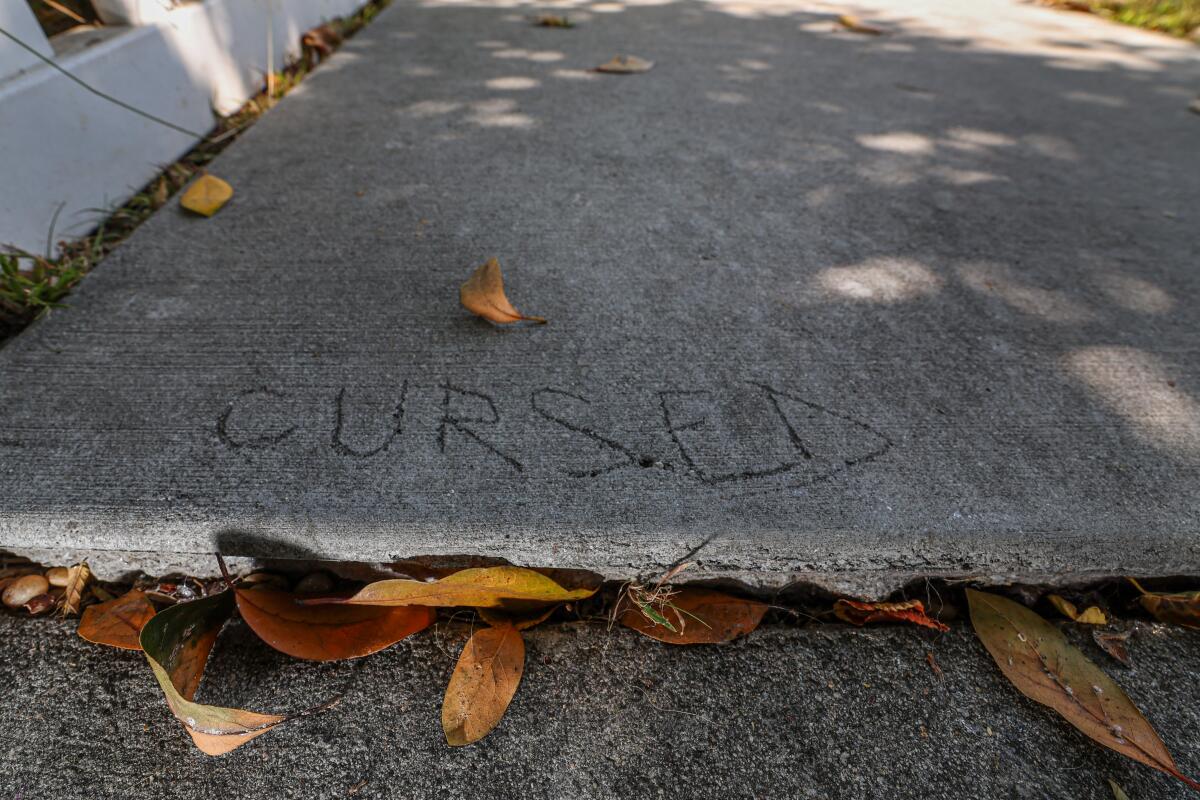
- Share via
It’s taken me a few weeks of research, but I think I finally have some answers about what to do if you live in the city of Los Angeles and would like to have sidewalks that don’t resemble obstacle courses.
Your first and best option is to pack up, sell the house and move out of town. Literally, tens of thousands of sidewalks have been mangled and cratered for decades, so it’s time to give up the fight. Surrounding communities do a much better job on the basics.
Your second best bet is to stay put and get yourself a burro. These sturdy and loyal animals could handle most of the jagged peaks and snaking tree roots that define Los Angeles, and if they happen to take a tumble, you can sue the city like thousands of others have and retire early.
California is about to be hit by an aging population wave, and Steve Lopez is riding it. His column focuses on the blessings and burdens of advancing age — and how some folks are challenging the stigma associated with older adults.
If none of that appeals to you, and you would prefer to apply for a fix through the existing sidewalk repair system, I’ve got a news flash for you:
There is no system.
Sure, you can go to the city’s MyLA311 service portal and start the process of requesting help, but just the other day in a conversation with Mayor Karen Bass she acknowledged the 311 system is a disaster.
You can try the city’s Safe Sidewalks L.A. website, and it will appear as though there’s an efficient program in place for you to fix your own sidewalk and get a rebate, or to get a quick fix paid for by the city if the request is by, or for, people with disabilities.
Do not be fooled.
You know how there’s all this hubbub about getting L.A. in shape for the 2028 Summer Olympics? Given the sidewalk repair backlog, and the current rate of fixes, sidewalks will not be fixed in time for the 3038 Summer Olympics in the City of Angels.
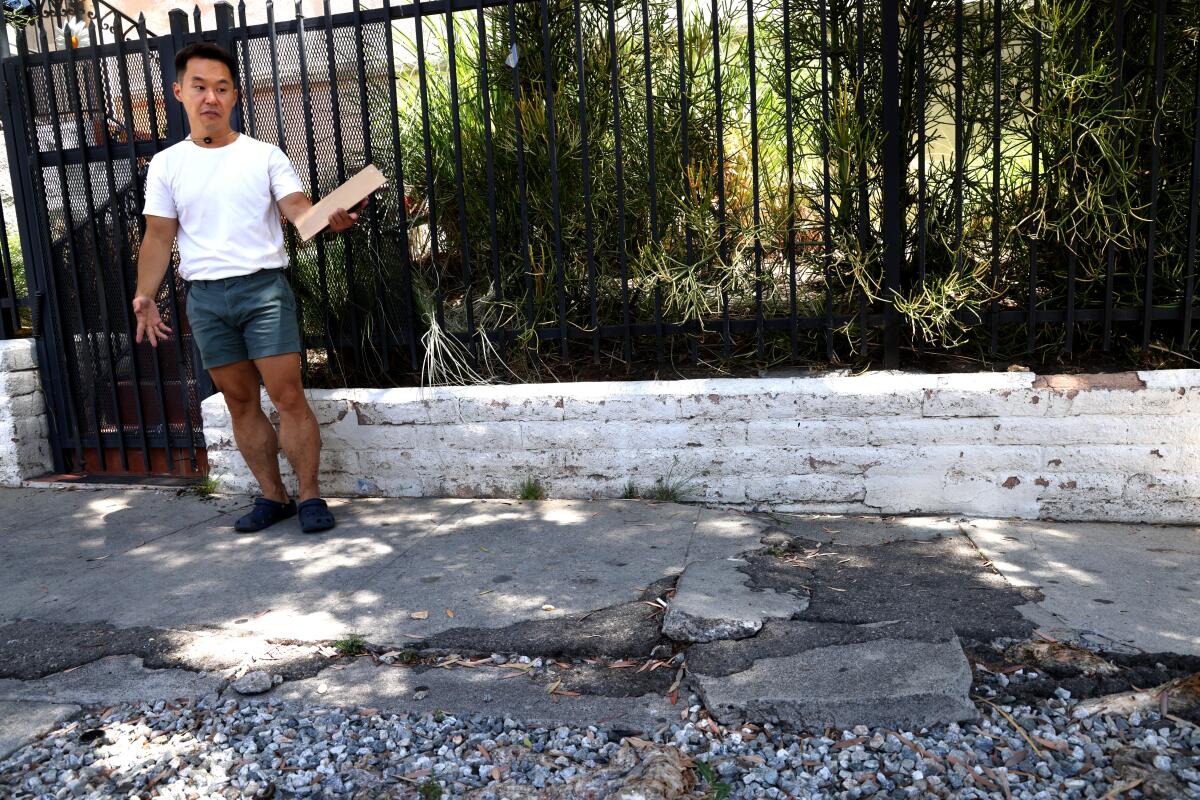
Property owners have good reason to be both irritated and confused, because the city has sent mixed signals for years. In 2016, city officials rolled out the “fix and release” program, saying it would repair all the sidewalks and then pass future maintenance responsibility over to the homeowner.
You didn’t fall for it, did you?
When Daffodil Tyminski of Venice contacted City Hall a month ago, hoping she could finally get some help with busted sidewalks after 20 years of failed attempts, she was told that fixes are the responsibility of the property owner. And she wasn’t the only one who read my last column on sidewalks and wondered whatever happened to fix and release.
I made an honest effort to find out but fell down a rabbit hole. Can I sue the city for that?
An Aug. 30, 2023, summary by the city Bureau of Engineering noted that the fix-and-release plan was never fully “effectuated” and it fizzled. The report recommended a “fix without release” plan I couldn’t quite comprehend, and it called for input from several city departments, which is always the kiss of death in L.A.
I sent a few questions to the city administrative officer, who told me more than once, over the course of a week of emails, that he was about to respond, but he never really did. He suggested I try the Public Works Department, and that was another week of back and forth. It’s not as if I was asking trick questions, either. Just your basic “what’s up?”
In the end, I got an email from a spokesperson who said his job is funded by the Sanitation Department but he is assigned to the Public Works Department, which gives you some insight into the depths of the rabbit holes.
“The policy relating to sidewalk repairs generally is being evaluated to ensure Angelenos are best served as efficiently as possible,” he wrote to me.
Well, that clears things up, doesn’t it?
He also seemed to be suggesting that the property owner is generally responsible for repairs. But it’s hard for me to be certain, because I’m not even sure city officials — including the mayor — are certain.
Bass told me she had informed the head of the city Department of Disability that she wants deputy mayors and other department heads to get together and “figure out how we fix the most extreme” sections of bad sidewalk as quickly as possible.

“I cited Sepulveda and La Brea — it’s really all over town — and asked for mapping and a list of sidewalks that are unwalkable,” Bass told me. “Some of the sidewalk on La Brea is so bad, you would have to walk in traffic, almost, but you can’t.”
I like the honesty, but not the game plan.
Do we really need a map, a list, or another meeting?
The bad sidewalks, most of them destroyed by trees the city has never properly maintained and never will, have been a fixture in L.A. for decades. We know where they are.
So here’s my suggestion:
The mayor gets around town quite a bit, right? Every time she sees an unwalkable sidewalk, she should get on the phone to the head of Public Works, and to the council member who represents that district, and tell them to have the sidewalk fixed before the week is out, even if they have to do it themselves.
Nothing is ever going to change unless someone takes charge here.
UCLA professor Donald Shoup told me he thinks the city should borrow a ton of money, hire contractors to fix sidewalks in time for the Olympics, and have property owners reimburse the city when they sell.
That works in theory, but it would take the city two years to identify the stakeholders and two more to do a feasibility study.
“It’s organized abandonment,” said Jessica Meaney of the nonprofit Investing in Place, which advocates for sensible planning and budgeting to improve infrastructure and public spaces. “I think the bottom line is that there is no sidewalk policy ... and the city has defaulted to blaming and holding property owners responsible.”
The city still does handle sidewalk repairs if the service request is by or for someone who is disabled, but that program is nothing to cheer about.
In 2016, under terms of a federal disabled rights lawsuit known as the Willits case, the city agreed to spend nearly $1.4 billion on repairs over 30 years. Unfortunately, the city’s annual commitment of $30 million or more hasn’t been enough to make much of a dent in a backlog that’s in the thousands.
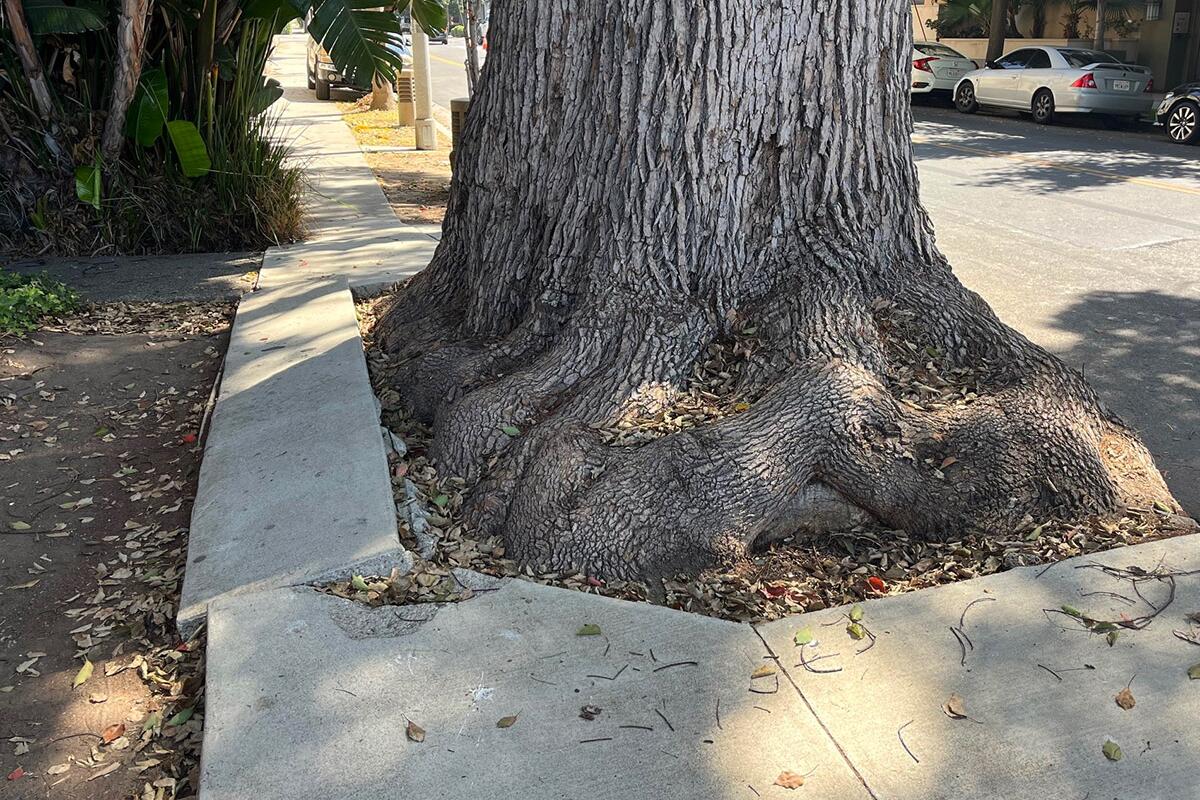
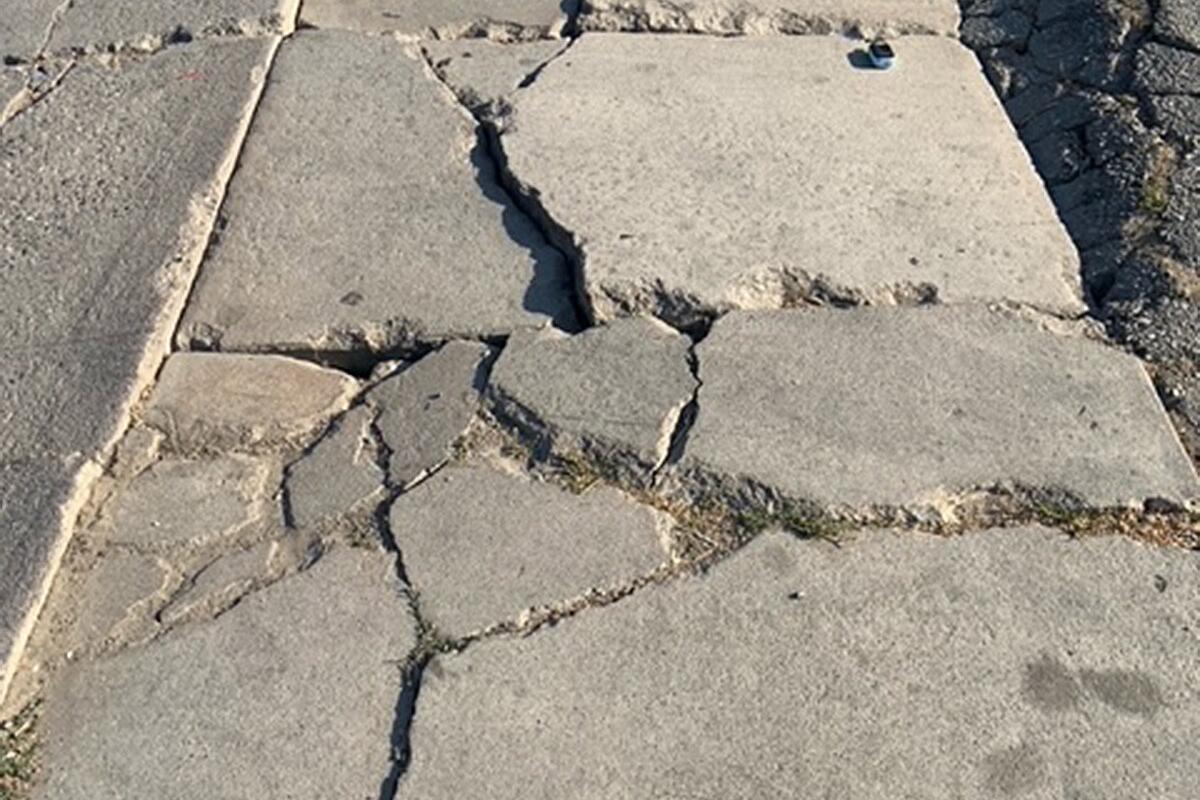
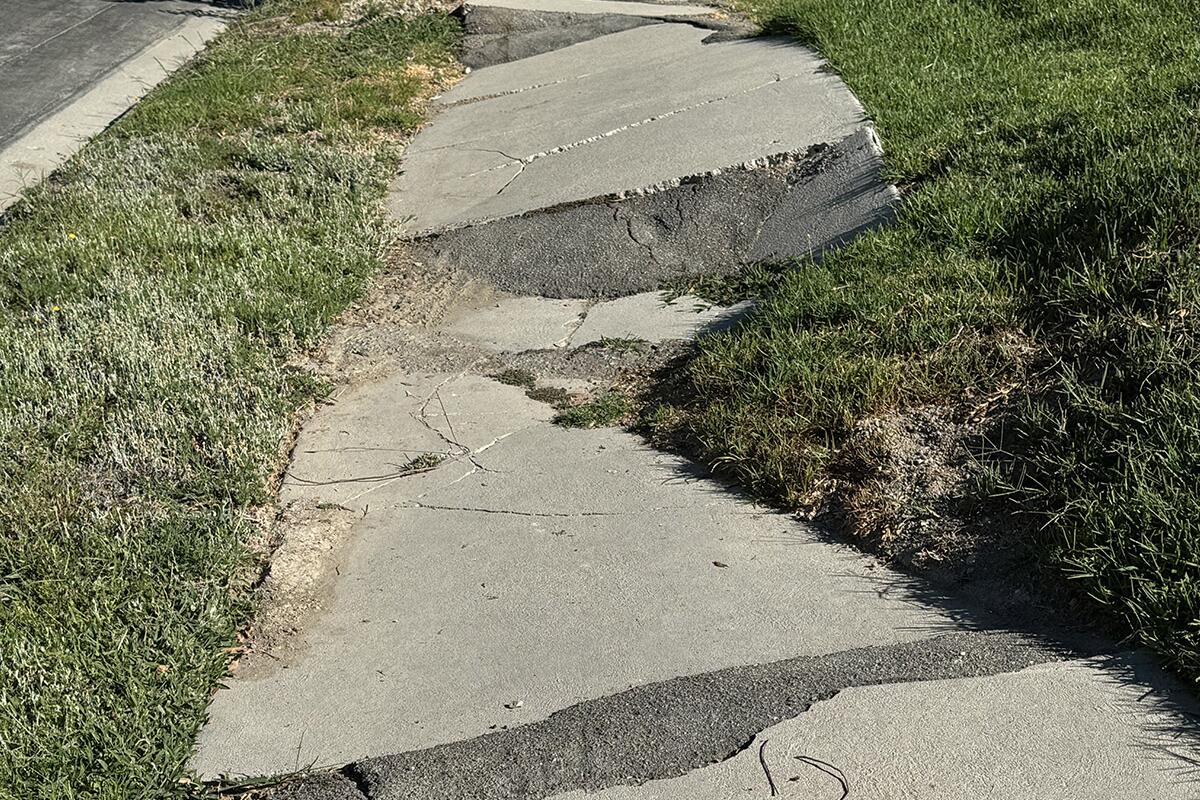
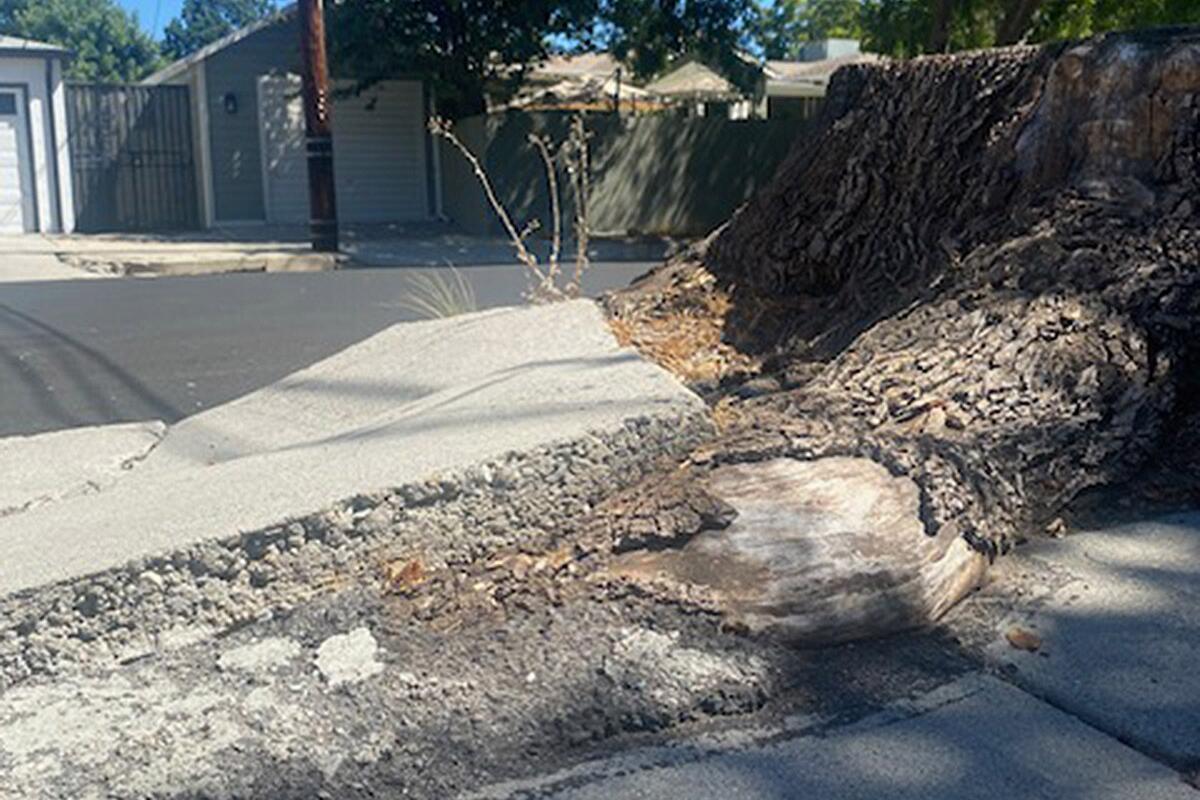
Top left: Joe Linton shared this image of a sidewalk that has deferred to the tree in West L.A. on Ohio Avenue. Top right: Michael Peraza shared this image of a crumpled sidewalk in the 600 block of N. Gower Street in Los Angeles. Bottom left: David Moles shared this image of a sidewalk lifted by an embankment in the 5700 block of Valerie Avenue in Woodland Hills. Bottom right: Babette Wilk shares this image of a tree in Valley Village taken down years ago by the city that still appears to have some life in it.
Venice resident Thahn Tran discovered this in June. She has a disabled tenant and was able to get into the queue for repairs of her cracked sidewalk. But her request was not deemed as a top-priority job, which she learned about in an email from the city’s Safe Sidewalks L.A. program.
And I quote:
“The Council adopted Sidewalk Repair Program Prioritization and Scoring System assists the Program with prioritizing the overwhelming number of Access Requests. We currently have over 3,500 pending Access Requests.”
For clarification, that backlog is separate from the 50,000 service requests that do not have disabled access prioritization, as noted in a 2021 audit.
But wait. I haven’t gotten to the best part of the email.
“Your Access Request has a priority score of 30, out of a maximum score of 45. It is in a residential zone (15 points), and it is within 500 ft radius of a bus or transit stop (15 points). However, it has not been in the queue for over 120 days.”
Here, now, is the soul crusher:
“Currently, the estimated wait time for completion of an Access Request with a score of 30 is in excess of 10 years.”
In excess of. So they’re not even guaranteeing that a repair crew will arrive by 2034.
“It’s ridiculous. I mean, come on. Why are we paying taxes?” asked Tran, an aerospace engineer. “I’ll be dead in 10 years.”
But Angelenos are nothing if not resourceful.
In their Cheviot Hills neighborhood, Ken and Julie Uslan tell me, they have “resorted to walking in the street, where it feels safer than our sidewalks.” They, too, were surprised to hear it could take 10 years before the city makes the fixes.
My advice? Do not be surprised if it takes only 10 years. Be grateful.
As for the do-it-yourself rebate option I mentioned earlier, would you be shocked to hear that it’s not a model of efficiency?
The deal is, you hire a private contractor to make the repairs, and the city will cover a portion of the cost up to about $12,000. The first problem here is that a lot of people with broken sidewalks can’t afford to fix them, even with financial help. And the 2021 audit by then-City Controller Ron Galperin found “a lengthy and complex” rebate process, naturally, in which it could take nearly a year to get that rebate check.
“The city is making it really hard for homeowners to actually fix their own sidewalks,” said Alonso Romero, a Sherman Oaks contractor whose Safer Sidewalks website breaks down city programs and repair options.
Romero said about 80% of his rebate customers back out when city inspectors require them to repair more than just the worst portions of their sidewalks, often turning a $5,000-$10,000 repair into a job of $20,000 or more.
“It is driving me crazy,” Romero said.
I think that’s the plan, to the extent there is a plan at all.
I do want to thank the dozens of readers who have sent me magnificent photos of their mangled sidewalks.
I had meant the burro line as a joke, but now I’m thinking it’s not such a bad idea.
More to Read
Sign up for Essential California
The most important California stories and recommendations in your inbox every morning.
You may occasionally receive promotional content from the Los Angeles Times.










